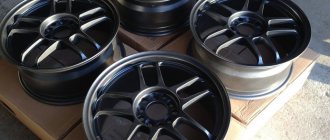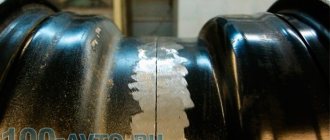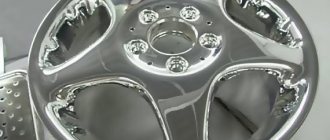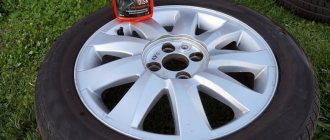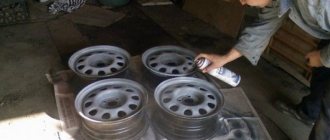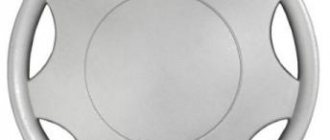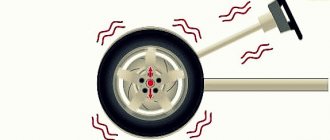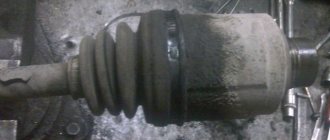Marking of car wheel rims is divided into two types - standard and additional. Standard information includes information about the width of the rim, the type of edge, rim split, mounting diameter, ring lugs, offset, etc.
As for additional markings, this includes information about the maximum permissible load, the maximum permissible tire pressure, information about the methods of manufacturing the disk, information about the international certification of a particular disk. However, not every car rim will have all the information listed above. Most products provide only some of the information provided.
Basic disk parameters
The marking will roughly look like this: 7.5J×15 H2 5×100 ET40 d54.1, where:
Jaguar alloy wheel
- 7.5 - landing width, indicated in inches (possibly written in the marking as a fraction).
- J is the shape of the side edge; it is not particularly taken into account when selecting.
- 15 is the diameter, measured in inches. You need to know that this is not the outer diameter, but the one on which the side of the lid fits.
- H2 is the encryption (code) of the design and the number of small protrusions to prevent the tire without a tube from falling off the disk - humps. This is not taken into account when choosing.
- 5x100 - these are the fastening parameters, bolt pattern: the number of holes for fastening, the diameter on which they are located, in other words - PCD.
- ET40 - wheel (disk) offset is the distance between the width and the outer plane of the disk (the wall of which presses the disk to the hub), measured in mm.
- d54.1 - wheel hub diameter, DIA, measured in mm.
Bolt pattern
If the bolt pattern is incorrect, it will not be possible to tighten the wheel. Wheel bolt pattern is determined by two parameters:
- number of mounting holes;
- diameter of their location (PCD).
The diameter of the circle on which the mounting holes are located, as well as their number, are specified by the car manufacturer and this parameter should be strictly adhered to. Installing a disk with a PCD deviation of even a couple of millimeters will lead to the fact that such a wheel will “beat” strongly while driving. In addition, loose bolts will unscrew on their own.
For installation, special nuts and bolts are used for fastening the wheels. They can be purchased at tire centers and auto parts stores.
Factory parameters of wheel rims by car make
Analysis of the parameters and characteristics of a car's disk
There are official websites with a service for searching for factory parameters depending on the make of the car,
- https://tyretrader.ua/
- https://kakie-kolesa.ru/
- https://www.calc.ru/
- https://www.megatrack.ru/
- https://diskomarket.ru/
- https://www.koleso-razmer.ru/
These services are very convenient; they have filters, which speeds up the search for wheel rim parameters by car make.
You need to select the make of the car; when you enter the model, year of manufacture and engine type, the parameters of the car wheels will appear on the screen: tire sizes, offset, hub diameter. The principle of searching on sites is the same.
Example: in the filter you can select the car brand AUDI A3→year of manufacture 2000→engine size 1.6i→obtained data on the general parameters of the factory configuration:
- marking 6Jx15 5×100 ET 38 (deciphering is described above);
- PCD - 5*100;
- DIA - 57.1 mm;
- disk 195/65 R15 (195 - its width; 65 - height, is 65% of the width, 126, 75; R15 - dimension);
- replacement with 205/55 R16 is possible (price varies depending on parameters and manufacturer).
On the websites you can choose the brand of wheels; there are operating instructions for cars of different brands, where all the characteristics are indicated.
Such services can be used if the owner has a desire to change the factory wheel diameter or tire width. All information is borrowed from reliable sources of auto dealers.
You might be interested in this: Wheels for Toyota Land Cruiser Prado 120
Hub Bore Diameter
The hub seat ring and the central hole of the disc must be the same diameter. For car rims, the diameter of the central hole is measured in millimeters.
If it is smaller than the seat ring on the hub, the wheel cannot be installed. A disk with a central hole larger than the standard one (indicated by the manufacturer in the documentation) can be screwed on. For tight installation, in this case, additional centering rings are used. This option only works when installing alloy wheels - there must be strict compliance with stamped ones.
Features of marking non-factory wheels
Based on the type of manufacture, non-factory wheels are divided into 3 types:
- cast;
- forged;
- stamped.
When starting to choose them, it is advisable to know the recommended and maximum characteristics of the wheels offered by the manufacturer.
After all, even a slight deviation from the norm in the technical parameters of stamped and cast wheels affects both severe tire wear and the performance of the suspension under non-standard driving conditions and under extreme loads. Aggressive driving also leads to structural damage to the vehicle.
The parameters of cast wheels differ from stamped ones: the former are more expensive and short-lived. Cast ones are produced by casting from aluminum and titanium alloys; they are purchased more for aesthetics; they quickly wrinkle upon impact. It is very important to take into account that even a slight deviation from the car manufacturer’s recommendations in technical specifications is fraught with tire wear and suspension repairs. Forged - not cheap, but high quality.
Attention!
Cast wheels have thicker walls than stamped wheels, requiring longer bolts and studs.
Marking of alloy wheels
An example of marking for a MAC Bimmer 7Jx16 H2 PCD5×120 ET31 Dia72.6 alloy wheel:
- The decoding of the first numbers is described above.
- DIA 72.6 - the diameter of the mounting hole on the disk is 72.6 mm.
If the specified DIA indicator is less than the diameter of the hub cylinder, the disc cannot be placed on the hub; if it is more, it will “sit” only on the bolts, which will increase the load on the fasteners and the hub.
The stamped marking, suitable for the VAZ-2107, size 175/R13, looks like this: 5.57×13 4×98 ET16 Dia59.0.
Additionally marked on non-factory wheels:
- production date (week and year).
- SAE, ISO, TUV - the mark of the body - means that the disc has passed X-ray control and meets international standards.
- MAX LOAD 2000LB - means the maximum load on the wheel (indicated in kilograms or pounds).
Wheels for passenger cars are produced with a strong reserve. They will not withstand the load if they are installed on a bus or jeep; they change even with minor irregularities on the roads.
Note!
When choosing wheels, you need to pay attention to the recommendations on the maximum load on the disk.
Decoding
What other markings may be on the disk:
- MAX PSI 50 COLD - Indicates that the tire pressure should not exceed 50 psi.
- COLD (cold) - means that the pressure should be measured when the tire is cold.
- JWL is a designation that the manufacturer has additionally tested the product, JWL is for passenger cars.
- JWL-T - for buses and trucks.
- VIA is a marking applied after passing tests at the Japanese transport inspection.
You may be interested in this About original wheels for Toyota Corolla (Toyota Corolla)
Where are the markings on the discs?
As for the location of the inscription on alloy wheels, the corresponding information is usually indicated not around the perimeter of steel wheels, but on the spokes or on the outer side between them (at the location of the holes for mounting on the wheel). It all depends on the design of the particular disk. Typically, the inscriptions are located on the inside of the wheel spokes. Along the circumference of the hole for the hub nut, between the holes for the wheel bolts, some separate information is applied that relates to the size of the disk and its technical information.
On stamped discs, the markings are stamped on the surface on the inside or outside. There are two types of application. The first is when individual inscriptions are applied to the intermediate space between the mounting holes of the disks. In another version, information is indicated simply along the perimeter of the rim closer to its outer edge. On cheap drives, the second option is more common.
Selecting drives by parameters
A correctly selected disc is the key to accident-free driving; if it is incorrectly selected, there are the following risks:
- it will not be possible to install them on the hub;
- they will touch the shock absorber strut;
- the load on the bearings will increase;
- There is a possibility that the warranty will be canceled if the car is registered.
There are tables for selecting wheels depending on the characteristics: DIA, PCD and offset.
To select wheels according to parameters, you can use online services. It is enough to know the PCD parameter.
On these sites you can “try on” different wheels for your car, select the desired option and order without leaving your home. Prices and manufacturers are indicated in the catalogs.
What information is contained in the inscriptions on car rims?
Strictly speaking, the “discs” that we buy in auto parts stores are not actually discs at all, but wheels. And the “disc” marking is usually applied not to it, but to the wheel rim.
GOST R 52390–2005 “Disc wheels” defines a wheel as a rotating and load-transmitting unit (element) located between the tire and the hub. The wheel consists of two main parts: the rim and the central disk.
A careful study of the markings will help you not only make sure that this design has been tested and its use will be safe, but also understand whether the wheel is suitable for installation on your car.
If during installation problems arise with the disks, in particular with the centering rings, then it is better not to take the initiative, but to immediately give them to the professionals www.remontdiskov.ru. This way you will save both time and money.
How to decipher the markings
All disks, regardless of whether they are cast or stamped, have standard markings. In any case, the designation must contain:
- the Latin letter I or S, indicating whether the wheel is “identical” (I), that is, exactly the same as the wheels that were installed on production cars, or special (S), which was certified without being “linked” to any car . For elements that were included in the certified vehicle (original), the letter marking is not applied, but they may indicate the designation of the vehicle manufacturer and the spare parts catalog number;
- manufacturer's name or trademark;
- wheel rim profile designation;
- rim offset size in millimeters;
- date of manufacture (at least month and year);
- serial number (designation).
What do the numbers on the rim mean?
The rim marking consists of the following symbols:
- rim contour (shape of the side flange);
- nominal diameter (usually in inches);
- nominal width (also usually in inches);
- symbol of a one-piece rim (on all modern passenger cars the one-piece rim is the “x” sign).
The marking of wheel rims from all manufacturers is subject to the same rules.
What you need to know to choose the right discs according to parameters
Regardless of the make of the car, to correctly select new wheels, you must take into account the basic parameters presented below.
Diameter
You need to follow the car manufacturer's advice; the diameter of the rim is equal to the seat diameter of the tire. Currently, it is fashionable to increase the factory diameter and change to low-profile tires: for example, 17 to 19.
Additional Information!
As the tire diameter increases, the car becomes more drivable, but comfort suffers and the load on the suspension and hub increases.
Rim width
Manufacturers allow a deviation in rim width of no more than 0.5-1 inches with a diameter of up to 14 inches. The best option is to use a factory-width disk. As the width changes, ride quality deteriorates.
There is another way to select the width: you need to subtract 20% from the tread width. If you take a 175/70 R13 tire:
- Its tread width: 175 mm – 20% = 140 mm;
- 140 : 25.4 (1 inch = 25.4 mm) = 5.51 inches, rounded to standard value, required rim width of 5.5 inches for a 175/70 R13 tire. This method is applicable when it is not possible to use a table from the catalog.
It is not worth installing discs with PCD violations, this risks causing the load on the bolts and their “tightness” to be different.
The wheel will not fit tightly onto the hub. When driving, the nuts will loosen.
Wheel offset (ET)
With a higher ET, the disc fits more tightly into the wheel recess. At a lower value, it sticks out, so motorists try to reduce the wheel offset. It is allowed to change the wheel offset by no more than 8 mm in both directions from the factory parameters.
Important!
Increasing the reach leads to increased racing performance: the car corners better at speed. The controllability of the car suffers from this, vibration on the steering wheel may occur from shocks, which negatively affects the suspension.
How to choose a wheel rim
When choosing a particular disc, car owners often have a problem - how to choose the right disc in accordance with the available tires. Let's look at a specific example of tires marked 185/60 R14. The width of the rim, in accordance with the requirements, must be 25% less than the width of the tire profile. Accordingly, it is necessary to subtract one quarter from the value of 185 and convert the resulting value into inches. The result will be five and a half inches.
Please note that for wheels with a diameter of no more than 15 inches, deviation in width from ideal conditions is allowed by no more than one inch. If the wheel is more than 15 inches in diameter, then the permissible error may be one and a half inches.
Thus, after the above calculations, we can say that for a 185/60 R14 tire a disk with a diameter of 14 inches and a width of 5.5...6.0 inches is suitable. The remaining parameters listed above must be clarified in the technical documentation for the car.
The following is a table that summarizes information about standard (factory) installed disks acceptable by their manufacturers. Accordingly, for cars it is necessary to choose wheels with suitable parameters.
| Automobile model | Factory wheel sizes and details |
| Toyota Corolla 2010 | 6Jx15 5/114.3 ET39 d60.1 |
| Ford Focus 2 | 5JR16 5×108 ET52.5 DIA 63.3 |
| Lada Granta | 13 / 5.0J PCD 4×98 ET 40 CO 58.5 or 14 / 5.5J PCD 4×98 ET 37 CO 58.5 |
| Lada Vesta 2021 release | 6Jx15 4/100 ET50 d60.1 |
| 2021 Hyundai Solaris | 6Jx15 4/100 ET46 d54.1 |
| 2015 Kia Sportage | 6.5Jx16 5/114.3 ET31.5 d67.1 |
| Kia Rio | PCD 4×100 with diameter from 13 to 15, width from 5J to 6J, offset from 34 to 48 |
| Niva | Bolt pattern - 5×139.7, offset - ET 40, width - 6.5 J, centering hole - CO 98.6 |
| Renault Duster 2011 | Size - 16x6.5, ET45, bolt pattern - 5x114.3 |
| Renault Logan 2021 | 6Jx15 4/100 ET40 d60.1 |
| VAZ 2109 2006 | 5Jx13 4/98 ET35 d58.6 |
UGI2 UGIA Product Images
A car needs a propulsion device - a device that provides contact with the road and transmits forces and moments that set the car in motion. In other words, four wheels, each of which consists of a tire, rim, connecting element (disc) and hub. What is encrypted in the wheel markings? To read the “secret script”, use our hint.
The code by which you can select a wheel for a specific car is deciphered as follows:
American tire markings
American tire manufacturers have their own markings. There are two types of markings: The first is very similar to the European one, only the letters “ P ” (Passanger - for a passenger car) or “ LT ” (Light Truck) are placed in front of the standard size. For example: P 195/55 R 14 or LT 235/65 R 15. And other markings, which are fundamentally different from the European ones. For example: 31x10.5 R15 31 - outer diameter of the tire in inches. 10.5 - tire width in inches. 3 R - radial tire. 15 is the inner diameter of the tire in inches. Additional designations used by tire manufacturers
- M&S (Mud + Snow - mud plus snow). This means that these tires are specifically designed as winter or all-season tires.
- M/T (Mud Terrain) - mud landscapes.
- A/T (All Terrain) - all-season tires.
- AS - All Season - all-season
- Any Season is an all-season tire.
- R+W (Road + Winter) - all-season tire.
- All Season is an all-season tire designed for year-round use.
- Rotation - sports tires with a directional tread pattern have an arrow on the sidewall of the tire indicating the required direction of rotation of the tire.
- Outside and Inside (or Side Facing Out and Side Facing Inwards ) are asymmetrical tires, when installing which you must strictly follow the rule for installing the tire on the rim. The inscription Outside (outside) should be on the outside of the car, and Inside (inside) - on the inside.
- Left or Right - means that the tires of this model are left and right. When installing them, you must strictly follow the rule for installing the tire on the car: left ones only on the left, and right ones, accordingly, only on the right.
- Steel Radial - radial tire with metal cord
- Tubeless (TL) - tubeless tire. If this inscription is not present, then the tire can only be used with a tube.
- Tube Type (TT)—the tire must be used with a tube.
- MAX PRESSURE - maximum permissible tire pressure, in kPa.
- RAIN , WATER , AQUA (or umbrella pictogram) - means that these tires are specially designed for rainy weather and have a high degree of protection against aquaplaning.
- Treadwear 380 - wear resistance coefficient, determined in relation to the “base tire”, for which it is equal to 100. The wear indicator is a theoretical value and cannot be directly related to the practical life of the tire, which is significantly influenced by road conditions, driving style, compliance pressure recommendations, adjusting car wheel alignment angles and wheel rotation. The wear indicator is presented as a number from 60 to 620 with an interval of 20 units. The higher its value, the longer the protector will withstand when tested according to the established methodology.
- Traction A - coefficient of adhesion, has values A, B, C. Coefficient A has the largest amount of adhesion in its class.
- Max Load - maximum load and then the values are in kilograms and pounds.
- PR (Ply Rating) - the strength (bearing capacity) of the frame is conditionally assessed by the so-called ply rate. The stronger the carcass, the more air pressure the tire can withstand and, therefore, have a greater load capacity. For passenger cars, tires with a ply rating of 4PR and sometimes 6PR are used, and in this case the latter are labeled “Reinforced”, i.e. “reinforced” (tires with increased load capacity).
- Extra Load (XL) - increased load index.
- Reinforced (Reinf or RF) - increased load index.
- On light trucks and minibuses, the most common tires are 6PR and 8PR. The increased ply (i.e. strength) of the tire can be indicated by the letter “ C ” (commercial), which is placed after the designation of the bore diameter (for example, 185R14C)
- TWI - the sign is located on the sidewall of the tire and shows the location of the remaining tread height marks in the main grooves. For the countries of the European Union and the Russian Federation, the remaining tread height of a worn passenger tire must be at least 1.6 mm.
- ZP - zero pressure (Zéro Pression), Michelin's commercial designation for tires with reinforced sidewalls. ZP: Possibility to continue driving in case of a puncture for a distance of up to 80 km at a speed of up to 80 km/h. ZP SR: Possibility to continue driving in case of a puncture for a distance of up to 30 km at speeds of up to 80 km/h.
- SST - Self Supporting Tires. These tires can carry the load and continue driving after a puncture.
- Dunlop MFS (Maximum Flange Sheild) - The Maximum Bead Rim Protection system protects expensive wheels from damage to curbs and sidewalks - a rubber profile around the circumference of the tire, located on the lower part of the wall above the rim flange, forms a buffer zone.
- Studless - does not suit the studded fabric.
- Studdable - subject to studding. In addition, quality standards are indicated on the tires (the letter “E” in a circle is the European standard, “DOT” is the American standard).
Table of correspondence between tire size and rim width and diameter
| For passenger cars | ||
| Disc diameter (inches) | Tire size | Rim width (inches) |
| Profile height 80 | ||
| 13 | 135/80R13 | 3,5 |
| 145/80R13 | 4 | |
| 155/80R13 | 4,5 | |
| 165/80R13 | 4,5 | |
| 165R13 | 5 | |
| 14 | 175/80R14 | 5 |
| 185/80R14 | 5 | |
| Profile height 70 | ||
| 13 | 135/70R13 | 4 |
| 145/70R13 | 4,5 | |
| 155/70R13 | 4,5 | |
| 165/70R13 | 5 | |
| 175/70R13 | 5 | |
| 185/70R13 | 5,5 | |
| 14 | 165/70R14 | 5 |
| 175/70R14 | 5 | |
| 185/70R14 | 5,5 | |
| 195/70R14 | 6 | |
| Profile height 65 | ||
| 13 | 155/65R13 | 4,5 |
| 165/65R13 | 5 | |
| 175/65R13 | 5 | |
| 14 | 155/65R14 | 4,5 |
| 165/65R14 | 5 | |
| 175/65R14 | 5 | |
| 185/65R14 | 5,5 | |
| 195/65R14 | 6 | |
| 15 | 145/65R15 | 4,5 |
| 155/65R15 | 4,5 | |
| 165/65R15 | 5 | |
| 175/65R15 | 5 | |
| 185/65R15 | 5,5 | |
| 195/65R15 | 6 | |
| 205/65R15 | 6 | |
| 215/65R15 | 6,5 | |
| 16 | 215/65R16 | 6,5 |
| 17 | 235/65R17 | 7 |
| 18 | 235/65R18 | 7 |
| Profile height 60 | ||
| 14 | 165/60R14 | 5 |
| 175/60R14 | 5 | |
| 185/60R14 | 5,5 | |
| 195/60R14 | 6 | |
| 15 | 175/60R15 | 5 |
| 185/60R15 | 5,5 | |
| 195/60R15 | 6 | |
| 205/60R15 | 6 | |
| 225/60R15 | 6,5 | |
| 16 | 205/60R16 | 6 |
| 215/60R16 | 6,5 | |
| 225/60R16 | 6,5 | |
| 235/60R16 | 7 | |
| 17 | 225/60R17 | 6,5 |
| Profile height 55 | ||
| 14 | 185/55R14 | 6 |
| 15 | 175/55R15 | 5,5 |
| 185/55R15 | 6 | |
| 195/55R15 | 6 | |
| 205/55R15 | 6,5 | |
| 225/55R15 | 7 | |
| 16 | 195/55R16 | 6 |
| 205/55R16 | 6,5 | |
| 215/55R16 | 7 | |
| 225/55R16 | 7 | |
| 245/55R16 | 7,5 | |
| 17 | 205/55R17 | 6,5 |
| 215/55R17 | 7 | |
| 225/55R17 | 7 | |
| 235/55R17 | 7,5 | |
| 245/55R17 | 7,5 | |
| 255/55R17 | 8 | |
| Profile height 50 | ||
| 15 | 195/50R15 | 6 |
| 205/50R15 | 6,5 | |
| 225/50R15 | 7 | |
| 16 | 185/50R16 | 6 |
| 195/50R16 | 6 | |
| 205/50R16 | 6,5 | |
| 215/50R16 | 7 | |
| 225/50R16 | 7 | |
| 235/50R16 | 7,5 | |
| 245/50R16 | 7,5 | |
| 255/50R16 | 8 | |
| 17 | 205/50R17 | 6,5 |
| 215/50R17 | 7 | |
| 225/50R17 | 7 | |
| 235/50R17 | 7,5 | |
| 18 | 235/50R18 | 7,5 |
| 245/50R18 | 7,5 | |
| 19 | 275/50R19 | 8,5 |
| Profile height 45 | ||
| 15 | 195/45R15 | 6,5 |
| 16 | 195/45R16 | 6,5 |
| 205/45R16 | 7 | |
| 215/45R16 | 7 | |
| 225/45R16 | 7,5 | |
| 245/45R16 | 8 | |
| 17 | 205/45R17 | 7 |
| 215/45R17 | 7 | |
| 225/45R17 | 7,5 | |
| 235/45R17 | 8 | |
| 245/45R17 | 8 | |
| 255/45R17 | 8,5 | |
| 18 | 215/45R18 | 7 |
| 225/45R18 | 7,5 | |
| 235/45R18 | 8 | |
| 245/45R18 | 8 | |
| 255/45R18 | 8,5 | |
| 275/45R18 | 9 | |
| 19 | 245/45R19 | 8 |
| 20 | 275/45R20 | 9 |
| Profile height 40 | ||
| 16 | 215/40R16 | 7,5 |
| 17 | 205/40R17 | 7,5 |
| 215/40R17 | 7,5 | |
| 235/40R17 | 8,5 | |
| 245/40R17 | 8,5 | |
| 255/40R17 | 9 | |
| 265/40R17 | 9,5 | |
| 275/40R17 | 9,5 | |
| 285/40R17 | 10 | |
| 18 | 205/40R18 | 7,5 |
| 225/40R18 | 8 | |
| 235/40R18 | 8,5 | |
| 245/40R18 | 8,5 | |
| 255/40R18 | 9 | |
| 265/40R18 | 9,5 | |
| 275/40R18 | 9,5 | |
| 285/40R18 | 10 | |
| 19 | 225/40R19 | 8 |
| 245/40R19 | 8,5 | |
| 255/40R19 | 9 | |
| 275/40R19 | 9,5 | |
| 20 | 245/40R20 | 8,5 |
| Profile height 35 | ||
| 17 | 225/35R17 | 8 |
| 265/35R17 | 9,5 | |
| 335/35R17 | 12 | |
| 18 | 215/35R18 | 7,5 |
| 225/35R18 | 8 | |
| 235/35R18 | 8,5 | |
| 255/35R18 | 9 | |
| 265/35R18 | 9,5 | |
| 275/35R18 | 9,5 | |
| 285/35R18 | 10 | |
| 295/35R18 | 10,5 | |
| 345/35R18 | 12 | |
| 19 | 225/35R19 | 8 |
| 235/35R19 | 8,5 | |
| 245/35R19 | 8,5 | |
| 255/35R19 | 9 | |
| 265/35R19 | 9,5 | |
| 275/35R19 | 9,5 | |
| 285/35R19 | 10 | |
| 295/35R19 | 10,5 | |
| 20 | 245/35R20 | 8,5 |
| 255/35R20 | 9 | |
| 275/35R20 | 9,5 | |
| 21 | 245/35R21 | 8,5 |
| 255/35R21 | 9 | |
| Profile height 30 | ||
| 18 | 285/30R18 | 10 |
| 295/30R18 | 10,5 | |
| 315/30R18 | 11 | |
| 335/30R18 | 12 | |
| 345/30R18 | 12 | |
| 19 | 265/30R19 | 9,5 |
| 275/30R19 | 9,5 | |
| 285/30R19 | 10 | |
| 295/30R19 | 10,5 | |
| 305/30R19 | 11 | |
| 345/30R19 | 12 | |
| 20 | 235/30R20 | 8,5 |
| 245/30R20 | 8,5 | |
| 255/30R20 | 9 | |
| 285/30R20 | 10 | |
| 335/30R20 | 12 | |
| 21 | 255/30R21 | 9 |
| 285/30R21 | 10 | |
| 295/30R21 | 10,5 | |
| 22 | 255/30R22 | 9 |
| Profile height 25 | ||
| 19 | 315/25R19 | 11,5 |
| 20 | 285/25R20 | 10,5 |
| 295/25R20 | 10,5 | |
| 325/25R20 | 12 | |
| 21 | 295/25R21 | 10,5 |
| 22 | 295/25R22 | 10,5 |
